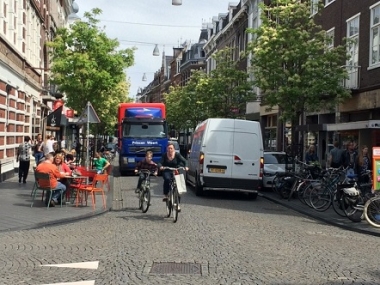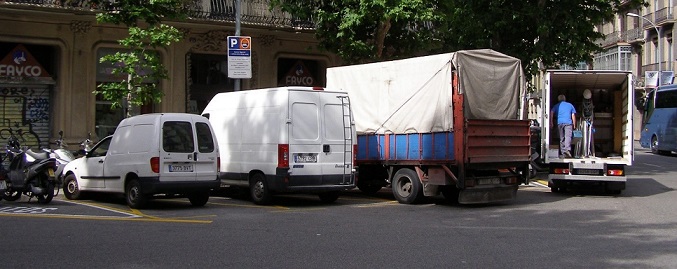Delivering thriving streets by understanding and managing freight activity
Edited on
16 August 2022By Ian Wainwright, Ad-hoc expert of Thriving Streets
What’s good about a thriving street? How does it work effectively? Perhaps it is the mix of activity and people, the shops and cafes, or the ability of pedestrians and cyclists to move about freely and safely. This ideal mixture may be pure coincidence, but if we try to re-engineer or even gently ‘nudge’ change onto an existing street how do we do it? And will it work?

It is a complex issue, but the answer to the second question will be a resounding ‘no’ unless we have thought about urban freight – the deliveries and collections of everything from construction materials to bread and waste, in trucks or vans, by bike or on foot.
Most people only think about freight when it goes wrong, there being no toilet paper at the start of the pandemic, or as the result of our online shopping or ordering food online, making us think about when the delivery will arrive. But our towns and cities have always been centres for deliveries, as markets, trading places and ports.
As towns and cities have grown, we have built new roads and new housing, and the movement of goods and services has changed in response to changing customer demands and business requirements. As a result, alongside the growth in car traffic, the majority of the freight in our towns and cities is now moved on the road network by trucks and vans, often from regional or national distribution centres many kilometres away.
Cities have started to tackle the negative impacts from this growth of road traffic such as poor air quality and road safety, and to address decarbonisation due to the climate crisis. Freight activity may be only 10 to 15% of urban traffic, but it often contributes disproportionally to greenhouse gas emissions and poor air quality. And simple physics means that heavier or faster vehicles are more dangerous than smaller, slower ones.
Local policies and strategies, such as a Clean Air Zone or a road safety ‘Vision Zero’ may be developed based on what has worked elsewhere. These may look at total traffic and identify the main issues and challenges, identifying appropriate solutions for different traffic types: pedestrians, cyclists, cars, public transport, and commercial freight traffic (trucks and vans).
While cities have always seen the movement of people as core to their activity, the same cannot be said for the movement of goods. Cities control public transport, they are responsible for cycle lanes and the pavements, but freight results from a private commercial activity between a customer and a supplier. This means that little or no public data exists and traditionally freight has not been seen as a city responsibility.
However, cities are responsible for many of the rules and regulations on their road network and are trying to change behaviours to ensure more active travel and healthier streets. These regulations and policies are as important for the movement of people as they are for the movement of goods. This gap in public knowledge needs to be addressed. But how? Recognising what we do not know is a good start.
Understanding freight
When was the last time you bought something and were asked which type of vehicle you wanted to deliver it to your front door, and were charged accordingly? The answer is never: what we buy may be from a few kilometres away or the other side of the globe, but the freight vehicle we see on our streets is determined by what we are buying, who we buy it from, how quickly we want it, and how much we are willing to pay.
We all love the idea of free delivery, but it is a complete fiction. The freight industry responds to customer demand and very few customers are willing to pay more for their goods. The costs are subsumed in the cost of the goods you buy or, in the worst cases, which are thankfully few, inflicted on society through dangerous vehicles and poor standards of driving.
As individuals and businesses, we consume a huge variety of goods and services requiring different freight operators and vehicle types. Fleets are usually small (typically less than six vehicles), lots of work is subcontracted or franchised, including from the big logistics names, and there are always competitors who say they can do it cheaper, faster, or greener, meaning profit margins are small.
There are also a whole range of national and local regulations that impact the vehicle size, weight, and roadworthiness; the driving time and training requirements, if any, for the driver or rider; land use planning for the allocation and design of warehousing sites; and traffic planning for where and when deliveries can take place.

(mixed delivery vehicles in Barcelona – c2010 ©FCL)
The power of engagement
This complexity of urban freight makes it difficult to know where to start. A local authority is unlikely to have much experience in freight transport planning to know what is right. There may be lobbying from stakeholders for specific solutions and solutions may appear to be common sense even when they are not.
For example, if facilities are available nearby, moving large amounts of freight by rail or water appears to be more efficient, while moving small home deliveries by cargo bike seems better for local residential streets, but both could add unacceptable costs for the final customer.
Many trials and pilots of consolidation centres, cargo bikes, retiming deliveries and other solutions have taken place. There is always a lot of publicity about the launch of a trial and individual changes that have occurred, but usually a lot less information about clear transformative results of the trial. Technology is also seen as an answer, but while it may help the industry to be more efficient, it cannot solve every problem and could even create new ones.
The vital element to managing urban freight is to understand the specific local circumstances and problems first, and then to identify what solutions might work and what actions need to occur. This will ensure that any solutions implemented are fit for purpose, and time, effort and money is well spent.
Stakeholder engagement is critical to defining the underlying problems that exist. A city may want to reduce congestion or introduce a new cycle lane, but it is the businesses that are ordering goods and the freight operators who are delivering them who really understand the daily situation of what is happening at the kerbside. They see what freight is moving locally and why, and the costs and benefits different operators and customers obtain from the way deliveries happen today.
Additional benefits can come from good engagement, such as vocal supporters and the identification of potential partners or funders, but stakeholder engagement may also strike fear, with a feeling that arguments will rage, and criticism of the local authority will be the only point of agreement.
There may be a degree of ‘taking it on the chin’ and quality engagement definitely needs dedicated staff to manage the process. Engagement may also increase the complexity of the solution and the timescales for delivery. However, I’d argue that this is all preferable to trying to impose solutions without knowing what actually happens, wasting public money, and ultimately failing to deliver change.
As a sneaky tip, the city will already employ people who know something about freight: those responsible for the collection of municipal waste, parking enforcement and economic development all spring to mind. There will also be specific local employers and businesses who are critical to the solutions which the city already engages with, e.g. the local port or hospital, or large manufacturing sites. Engaging with these colleagues first may help in developing the engagement plan and knowing what questions to ask.
What is the solution for my streets?
While various ‘solutions’ are mentioned in this article, there is no promotion of one over another: any or all could be part of the solution set needed to reduce the impacts of urban freight in a specific street or neighbourhood. The best solution is likely to come through local discussion with local stakeholders. It may not be perfect but if there is agreement and support, everyone is invested with making it work.
What the city planners and politicians really need is the confidence to know if the solution would work here, in this street, with these conditions. They also need to know what they need to do to make it happen.
In part, this is about learning from other cities and reaching out to stakeholders to get a better understanding of the impacts of customer requirements and supply chain complexities. It is also about thinking through a basic framework of ‘Avoid, Shift, Improve,’ as applied to urban freight.
This framework underpins many approaches to decarbonisation and can equally be applied to reducing the impacts of freight, if we think about:
- Avoiding road freight trips by changing mode to rail, water or bike; consolidating loads, especially through procurement activity; and ensuring joined-up transport and land use planning facilitates fewer movements through managing the supply of logistics land and the space for loading and unloading across the urban area;
- Shifting road freight trips to when space is available on the road network; by changing the time and place the delivery occurs; managing the route between the origin and destination; and
- Improving the trip with safer and low or zero-emission vehicles, well trained drivers and riders, and quiet delivery equipment.
All of the solutions mentioned in this framework are proven solutions and case studies exist. The framework also demonstrates we need to much bolder and to move beyond cleaner vehicles to make greater change.
How to make progress
Firstly, don’t panic! This may all sound complex, but very few people see the whole supply chain and even fewer understand it. The critical step is to recognise that freight is one important piece in the jigsaw puzzle to creating thriving streets. Accommodating and managing urban freight can then be considered as part of the ongoing integrated transport, mobility and land use planning processes, from city-wide strategies down to individual schemes, and clear targets can be established.
Stakeholder engagement will help identify the major issues, but openness is needed as some of these may appear to challenge existing regulations or seem counterintuitive or even be problematic for some residents and politicians. For example, stakeholders may suggest the need to review the existing regulations around delivery times or that better enforcement of the kerbside space is needed to help create the desired street space.
Agreeing to either of these changes may raise concerns, as deliveries out of hours need to be quiet and funding may be required for more frequent enforcement. Compromise is likely to be required from all sides, but recognising that city planning is an iterative process should enable greater experimentation and flexibility.
There is more guidance and research on urban freight being published every week and a ‘new’ solution seems to appear every day, either in a newspaper or on Twitter or even on TikTok. By dedicating one responsible person at the mobility department to work with freight there will be a growing understanding of potential solutions, and the successes and failures. This will also provide a route to coordinating the local freight approach across a wider urban area or region.
Finally, the municipality can be a catalyst for change by providing leadership through stakeholder engagement. The city could also develop a clear procurement policy ensuring all deliveries use zero-emission vehicles and drivers/riders are trained in urban delivery, demonstrating the effectiveness, costs and benefits for others to follow.
For more information please contact ian@futurecitylogistics.com
Submitted by Francesca Blamonti on
